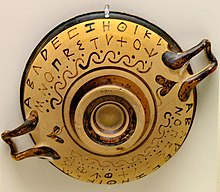Chi (letter)
 | ||||||||||||||||||||||||||||||||||||||||||||||||
| Greek alphabet | ||||||||||||||||||||||||||||||||||||||||||||||||
|---|---|---|---|---|---|---|---|---|---|---|---|---|---|---|---|---|---|---|---|---|---|---|---|---|---|---|---|---|---|---|---|---|---|---|---|---|---|---|---|---|---|---|---|---|---|---|---|---|
|
||||||||||||||||||||||||||||||||||||||||||||||||
| History | ||||||||||||||||||||||||||||||||||||||||||||||||
| Use in other languages | ||||||||||||||||||||||||||||||||||||||||||||||||
| Related topics | ||||||||||||||||||||||||||||||||||||||||||||||||
| ||||||||||||||||||||||||||||||||||||||||||||||||
Chi /ˈkaɪ/ (![]() listen)[1] (uppercase Χ, lowercase χ; Greek: χῖ) is the 22nd letter of the Greek alphabet.
listen)[1] (uppercase Χ, lowercase χ; Greek: χῖ) is the 22nd letter of the Greek alphabet.
Greek

Pronunciation
Ancient Greek
Its value in Ancient Greek was an aspirated velar stop /kʰ/ (in the Western Greek alphabet: /ks/).
Koine Greek
In Koine Greek and later dialects it became a fricative ([x]/[ç]) along with Θ and Φ.
Modern Greek
In Modern Greek, it has two distinct pronunciations: In front of high or front vowels (/e/ or /i/) it is pronounced as a voiceless palatal fricative [ç], as in German ich or like the h in some pronunciations of the English words hew and human. In front of low or back vowels (/a/, /o/ or /u/) and consonants, it is pronounced as a voiceless velar fricative ([x]), as in German ach.
Transliteration
Chi is romanized as ⟨ch⟩ in most systematic transliteration conventions, but sometimes ⟨kh⟩ is used.[2] In addition, in Modern Greek, it is often also romanized as ⟨h⟩ or ⟨x⟩ in informal practice.
Greek numeral
In the system of Greek numerals, it has a value of 600.
Xi
In ancient times, some local forms of the Greek alphabet used the chi instead of xi to represent the /ks/ sound. This was borrowed into the early Latin language, which led to the use of the letter X for the same sound in Latin, and many modern languages that use the Latin alphabet.
Cyrillic
Chi was also included in the Cyrillic script as the letter Х, with the phonetic value /x/ or /h/.
International Phonetic Alphabet
In the International Phonetic Alphabet, the minuscule chi is the symbol for the voiceless uvular fricative.
Chiasmus
Chi is the basis for the name literary chiastic structure and the name of chiasmus.
Symbolism
In Plato's Timaeus, it is explained that the two bands that form the soul of the world cross each other like the letter Χ. Plato's analogy, along with several other examples of chi as a symbol occur in Thomas Browne's discourse The Garden of Cyrus (1658).
Chi or X is often used to abbreviate the name Christ, as in the holiday Christmas (Xmas). When fused within a single typespace with the Greek letter Rho, it is called the labarum and used to represent the person of Jesus Christ.
Character encodings
Greek chi
| Preview | Χ | χ | ᵡ | ᵪ | ☧ | |||||
|---|---|---|---|---|---|---|---|---|---|---|
| Unicode name | GREEK CAPITAL LETTER CHI | GREEK SMALL LETTER CHI | MODIFIER LETTER SMALL CHI | GREEK SUBSCRIPT SMALL LETTER CHI | CHI RHO | |||||
| Encodings | decimal | hex | decimal | hex | decimal | hex | decimal | hex | decimal | hex |
| Unicode | 935 | U+03A7 | 967 | U+03C7 | 7521 | U+1D61 | 7530 | U+1D6A | 9767 | U+2627 |
| UTF-8 | 206 167 | CE A7 | 207 135 | CF 87 | 225 181 161 | E1 B5 A1 | 225 181 170 | E1 B5 AA | 226 152 167 | E2 98 A7 |
| Numeric character reference | Χ |
Χ |
χ |
χ |
ᵡ |
ᵡ |
ᵪ |
ᵪ |
☧ |
☧ |
| Named character reference | Χ | χ | ||||||||
| DOS Greek | 148 | 94 | 173 | AD | ||||||
| DOS Greek-2 | 210 | D2 | 243 | F3 | ||||||
| Windows 1253 | 214 | D6 | 246 | F6 | ||||||
| TeX | \chi | |||||||||
Coptic khi
| Preview | Ⲭ | ⲭ | ⳩ | |||
|---|---|---|---|---|---|---|
| Unicode name | COPTIC CAPITAL LETTER KHI | COPTIC SMALL LETTER KHI | COPTIC SYMBOL KHI RHO | |||
| Encodings | decimal | hex | decimal | hex | decimal | hex |
| Unicode | 11436 | U+2CAC | 11437 | U+2CAD | 11497 | U+2CE9 |
| UTF-8 | 226 178 172 | E2 B2 AC | 226 178 173 | E2 B2 AD | 226 179 169 | E2 B3 A9 |
| Numeric character reference | Ⲭ |
Ⲭ |
ⲭ |
ⲭ |
⳩ |
⳩ |
Latin chi
| Preview | Ꭓ | ꭓ | ꭔ | ꭕ | ||||
|---|---|---|---|---|---|---|---|---|
| Unicode name | LATIN CAPITAL LETTER CHI | LATIN SMALL LETTER CHI | LATIN SMALL LETTER CHI WITH LOW RIGHT RING | LATIN SMALL LETTER CHI WITH LOW LEFT SERIF | ||||
| Encodings | decimal | hex | decimal | hex | decimal | hex | decimal | hex |
| Unicode | 42931 | U+A7B3 | 43859 | U+AB53 | 43860 | U+AB54 | 43861 | U+AB55 |
| UTF-8 | 234 158 179 | EA 9E B3 | 234 173 147 | EA AD 93 | 234 173 148 | EA AD 94 | 234 173 149 | EA AD 95 |
| Numeric character reference | Ꭓ |
Ꭓ |
ꭓ |
ꭓ |
ꭔ |
ꭔ |
ꭕ |
ꭕ |
Mathematical chi
| Preview | ||
|---|---|---|